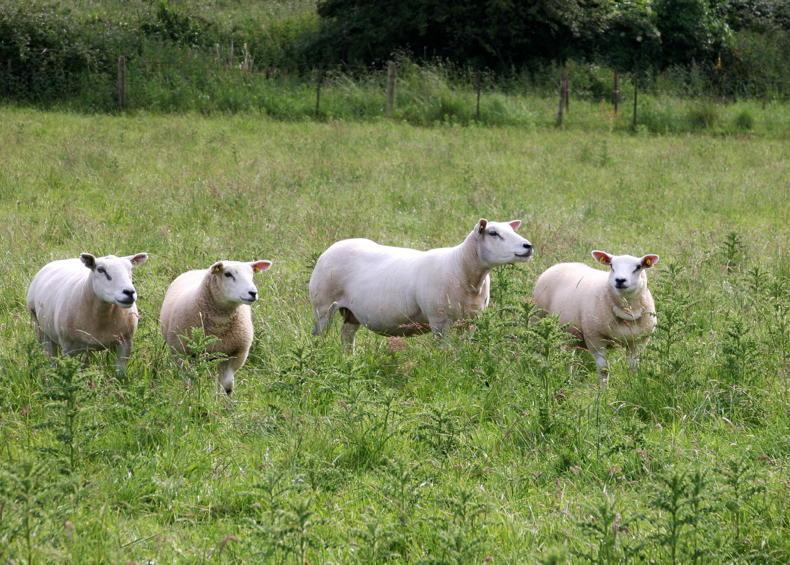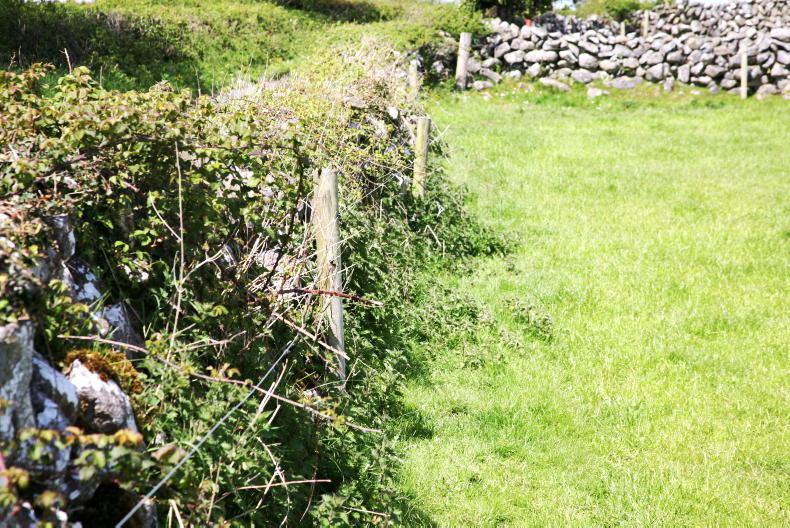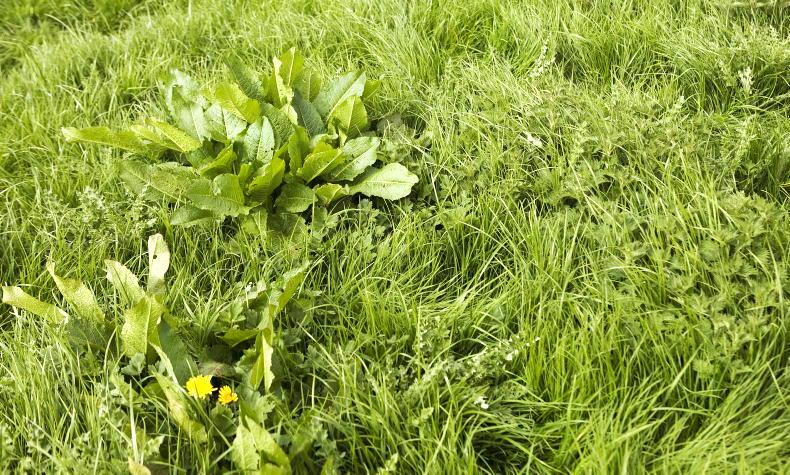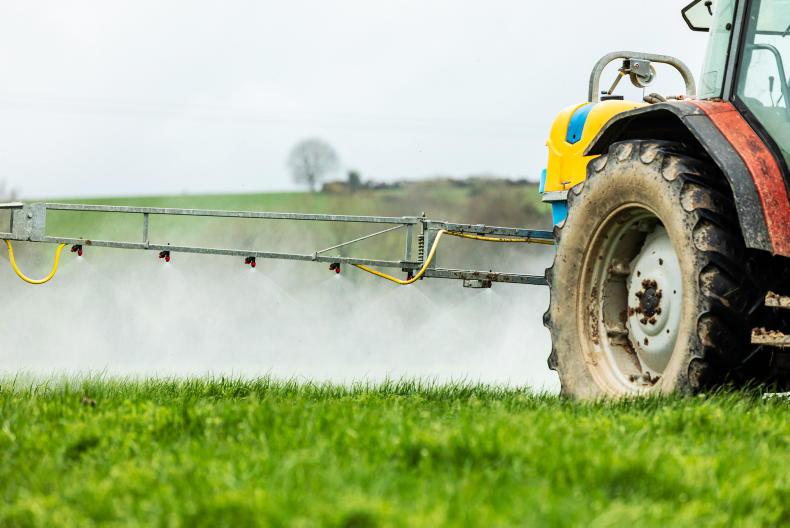Imbued with the most advanced chemistry in weed control technology, Forefront T has become the product of choice for a growing number of farmers seeking to clean pastures of a wide spectrum of weeds.
Manufactured by Corteva Agriscience and distributed on the Irish market by Whelehan Crop Protection, Forefront T contains two chemicals, aminopyralid and triclopyr.
This powerful combination makes it the perfect choice for docks, thistles and nettles as well as a range of other weeds such as buttercups, chickweed and dandelions. It is also the product of choice for ragwort.
Timing of the Spray
Chris Maughan, technical manager with Whelehan Crop Protection, said best results are achieved by spraying with Forefront T when weeds are actively growing and are at the right stage for a good kill of the root system.
Docks should be sprayed when 15-25cm high or across and before a seed head begins to show. Thistles should have four to 10 leaves and be 15-25cm high. Nettles should be sprayed before flowering.
“If weeds are gone beyond these stages, it is best to top them and spray with Forefront T after about three weeks regrowth when they are at the right stage for an effective kill,” advises Chris.
Apply Forefront T as a single application at 2l/ha in a minimum 200l of water/ha. Keep stock off the pasture for seven days after spraying.
Perfect for Ragwort
Forefront T is the perfect herbicide for controlling the noxious weed ragwort, which can be lethal to livestock.
A biennial plant, it grows as a rosette in the first year. In the second year, the rosette sends up one or more leafy unbranched stems which produce numerous flower heads. These can grow to be up to a 1m in height.
While topping or cutting can reduce the spread, it can ultimately lead to vigorous regrowth, thereby perpetuating the problem. Therefore, spraying with Forefront T is the best route to effective control.
Apply Forefront T when the ragwort is in the rosette stage and during a period of active growth with warm temperatures (above 10°C). Animals should be kept off pasture until the ragwort has completely disappeared.
This can normally take around three weeks, but when the plant starts to produce a stem it could take up to eight weeks for it to die.
In this situation, spraying in late autumn when pastures are being closed for the winter can work very well.

Fifty thistles per 20sq metres can mean a drop of 50% in grass dry matter yields. Thistles can also spread orf in sheep and other animal diseases such as pink eye and mastitis.
Thistles can cut grass output by half and spread disease
Thistles play havoc with grass and silage yields leading to a serious impact on animal performance. They also spread diseases such as orf, pink eye and mastitis.
Research has shown that animals leave 30cm of grass ungrazed around each thistle plant. Just one thistle per 20 sq metres is equivalent to a 1% loss in grass and silage dry matter. Therefore, 50 thistles per 20 sq metres, which is common in thistle-infested swards, can mean a drop of 50% in grass and silage dry matter yields.
Thistles also severely affect quality and palatability of hay and silage and are a serious impediment to the conservation of baled silage.
Creeping thistle seeds can survive in soil for 21 years. The roots of one creeping thistle can grow to cover five square metres in one year and up to 80 square metres in two years.
The weight of the underground creeping thistle root system can be up 2.5t/ha.
In its second year, a spear thistle can be over one metre in diameter before flowering. Each flower head produces up to 400 seed heads each of which can produce between 4,000 and 8,000 seeds. The seeds can remain viable for at least three years.
Thistlex: the proven herbicide
Thistlex is proven in independent trials and at farm level to be a highly effective product for long-term control of both creeping and spear thistles.
Another Corteva Agriscience herbicide, it contains the active ingredients triclopyr and clopyralid, which are absorbed right down to the roots of the thistles.
In contrast, MCPA-based products have very little impact on the root system. While killing the foliage of the thistle, they merely act as a ‘chemical topper’, with the thistles re-emerging the following season.
Chris Maughan stresses that, as with Forefront T and other systemic herbicides, timing of the Thistlex spray is vital to a successful kill.
“For best results, thistles should have four to 10 leaves and be 15cm to 25cm high. This is called the rosette stage. They should also be actively growing. If they have gone beyond this stage, it is best to top them and spray with Thistlex when they have regrown to the correct stage.”
Perfect solution for silage or hay swards
Where thistles are the major weed in silage or hay swards, Thistlex is also the perfect solution. Again, timing is important.
“Thistles should be at the correct growth stage and Thistlex should be applied at least three weeks before the silage or hay is cut. This ensures that the chemicals get right down to the root system. If the thistles or the crop are more advanced, it is better to wait and apply Thistlex about three weeks after the crop is cut,” says Chris Maughan.
Apply Thistlex at 1l/ha and use a minimum of 200l/ha (20 gals/acre) of water. Keep animals off treated pasture for seven days.

Grazon Pro is highly effective in clearing briars and other weeds at fences and ditches.
Grazon Pro: the ideal spot treatment
Grazon Pro is proven as the ideal and highly cost-effective product for spot treatment for a wide range of weeds. Nettles, thistles, briars, docks, buttercups, gorse, cow parsley and hogweed are among the weeds it controls.
It contains two powerful root killing ingredients – triclopyr and clopyralid. Triclopyr is particularly effective on brushwood, scrub and nettles. No other product on the market for knapsack application has as high a concentration of this powerful chemical.
Grazon Pro is the perfect solution for weeds around ditches, fences and gateways. Also, where weed infestations across a field or paddock are 5% or less, it is the most cost-effective choice.
It should be applied at a rate of 60ml in 10l of water using a conventional knapsack sprayer, a quad bike sprayer or a suitable lance on a tractor mounted sprayer. There is a measuring cap attached to each container.
It is rainfast within two hours and does not affect grass growth. Spray to thoroughly wet the foliage of the weeds, but avoid ‘run-off’. Treated weed patches are rapidly re-colonised by grass.
For more information please click here
Imbued with the most advanced chemistry in weed control technology, Forefront T has become the product of choice for a growing number of farmers seeking to clean pastures of a wide spectrum of weeds.
Manufactured by Corteva Agriscience and distributed on the Irish market by Whelehan Crop Protection, Forefront T contains two chemicals, aminopyralid and triclopyr.
This powerful combination makes it the perfect choice for docks, thistles and nettles as well as a range of other weeds such as buttercups, chickweed and dandelions. It is also the product of choice for ragwort.
Timing of the Spray
Chris Maughan, technical manager with Whelehan Crop Protection, said best results are achieved by spraying with Forefront T when weeds are actively growing and are at the right stage for a good kill of the root system.
Docks should be sprayed when 15-25cm high or across and before a seed head begins to show. Thistles should have four to 10 leaves and be 15-25cm high. Nettles should be sprayed before flowering.
“If weeds are gone beyond these stages, it is best to top them and spray with Forefront T after about three weeks regrowth when they are at the right stage for an effective kill,” advises Chris.
Apply Forefront T as a single application at 2l/ha in a minimum 200l of water/ha. Keep stock off the pasture for seven days after spraying.
Perfect for Ragwort
Forefront T is the perfect herbicide for controlling the noxious weed ragwort, which can be lethal to livestock.
A biennial plant, it grows as a rosette in the first year. In the second year, the rosette sends up one or more leafy unbranched stems which produce numerous flower heads. These can grow to be up to a 1m in height.
While topping or cutting can reduce the spread, it can ultimately lead to vigorous regrowth, thereby perpetuating the problem. Therefore, spraying with Forefront T is the best route to effective control.
Apply Forefront T when the ragwort is in the rosette stage and during a period of active growth with warm temperatures (above 10°C). Animals should be kept off pasture until the ragwort has completely disappeared.
This can normally take around three weeks, but when the plant starts to produce a stem it could take up to eight weeks for it to die.
In this situation, spraying in late autumn when pastures are being closed for the winter can work very well.

Fifty thistles per 20sq metres can mean a drop of 50% in grass dry matter yields. Thistles can also spread orf in sheep and other animal diseases such as pink eye and mastitis.
Thistles can cut grass output by half and spread disease
Thistles play havoc with grass and silage yields leading to a serious impact on animal performance. They also spread diseases such as orf, pink eye and mastitis.
Research has shown that animals leave 30cm of grass ungrazed around each thistle plant. Just one thistle per 20 sq metres is equivalent to a 1% loss in grass and silage dry matter. Therefore, 50 thistles per 20 sq metres, which is common in thistle-infested swards, can mean a drop of 50% in grass and silage dry matter yields.
Thistles also severely affect quality and palatability of hay and silage and are a serious impediment to the conservation of baled silage.
Creeping thistle seeds can survive in soil for 21 years. The roots of one creeping thistle can grow to cover five square metres in one year and up to 80 square metres in two years.
The weight of the underground creeping thistle root system can be up 2.5t/ha.
In its second year, a spear thistle can be over one metre in diameter before flowering. Each flower head produces up to 400 seed heads each of which can produce between 4,000 and 8,000 seeds. The seeds can remain viable for at least three years.
Thistlex: the proven herbicide
Thistlex is proven in independent trials and at farm level to be a highly effective product for long-term control of both creeping and spear thistles.
Another Corteva Agriscience herbicide, it contains the active ingredients triclopyr and clopyralid, which are absorbed right down to the roots of the thistles.
In contrast, MCPA-based products have very little impact on the root system. While killing the foliage of the thistle, they merely act as a ‘chemical topper’, with the thistles re-emerging the following season.
Chris Maughan stresses that, as with Forefront T and other systemic herbicides, timing of the Thistlex spray is vital to a successful kill.
“For best results, thistles should have four to 10 leaves and be 15cm to 25cm high. This is called the rosette stage. They should also be actively growing. If they have gone beyond this stage, it is best to top them and spray with Thistlex when they have regrown to the correct stage.”
Perfect solution for silage or hay swards
Where thistles are the major weed in silage or hay swards, Thistlex is also the perfect solution. Again, timing is important.
“Thistles should be at the correct growth stage and Thistlex should be applied at least three weeks before the silage or hay is cut. This ensures that the chemicals get right down to the root system. If the thistles or the crop are more advanced, it is better to wait and apply Thistlex about three weeks after the crop is cut,” says Chris Maughan.
Apply Thistlex at 1l/ha and use a minimum of 200l/ha (20 gals/acre) of water. Keep animals off treated pasture for seven days.

Grazon Pro is highly effective in clearing briars and other weeds at fences and ditches.
Grazon Pro: the ideal spot treatment
Grazon Pro is proven as the ideal and highly cost-effective product for spot treatment for a wide range of weeds. Nettles, thistles, briars, docks, buttercups, gorse, cow parsley and hogweed are among the weeds it controls.
It contains two powerful root killing ingredients – triclopyr and clopyralid. Triclopyr is particularly effective on brushwood, scrub and nettles. No other product on the market for knapsack application has as high a concentration of this powerful chemical.
Grazon Pro is the perfect solution for weeds around ditches, fences and gateways. Also, where weed infestations across a field or paddock are 5% or less, it is the most cost-effective choice.
It should be applied at a rate of 60ml in 10l of water using a conventional knapsack sprayer, a quad bike sprayer or a suitable lance on a tractor mounted sprayer. There is a measuring cap attached to each container.
It is rainfast within two hours and does not affect grass growth. Spray to thoroughly wet the foliage of the weeds, but avoid ‘run-off’. Treated weed patches are rapidly re-colonised by grass.
For more information please click here











SHARING OPTIONS